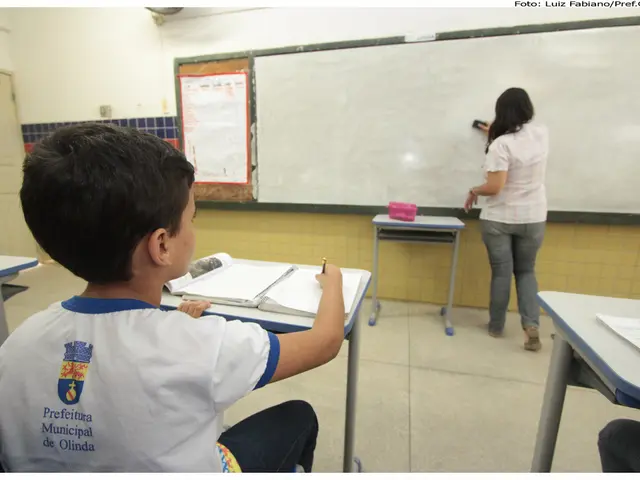Understanding and Using Metaphors: A Guide for Children - Meaning, Categories, and Examples Explained Simply
Teaching writing creativity in kids is all about simplifying complex concepts for them. Even though children are quick learners, grasping complex ideas like metaphors might take them some time. One important element of descriptive writing is the use of similes and metaphors. With tough metaphors being a challenge for kids, it's essential to introduce them to easy metaphor examples first. As children start comprehending metaphors, they'll enjoy reading more and, in turn, ace the use of metaphors in their writing.
What's a Metaphor?
Metaphors are frequently used in stories and poetry, but they can confuse young minds. Adults should explain metaphors to children by defining it as a word or phrase that draws a comparison between two unrelated things without using "like" or "as". Simply put, metaphors are a kind of figurative language used to compare two things or situations by creating a resemblance between the two.
Importance of Metaphors in Writing
Metaphors play a crucial role in descriptive writing, enabling writers to explain things differently or provide a unique insight into the subject. They add color and artistry to a writer's work and make words become more alive by making the subject more relatable for the reader. They simplify complex ideas and help make writing more interesting.
Types of Metaphors
There are various types of metaphors, each carrying a different meaning. The main types are:
- Extended/Sustained Metaphor: These are metaphors that are used for a longer duration and maintain the same comparison throughout the text or poem.
- Implied Metaphor: In these metaphors, two objects or ideas are compared without mentioning them directly or explicitly.
- Dead Metaphor: Dead metaphors are metaphors that have been overused to the point of being cliches, losing their impact.
- Everyday Metaphors: These are metaphors that compare everyday objects or situations.
- Animal Metaphor: Animal metaphors use animals to describe any object or situation.
- Nature Metaphors: Nature metaphors compare objects or situations to acts of nature or natural objects.
- Mixed Metaphor: Mixed metaphors involve two or more unrelated or incongruous metaphors to create a single metaphor, best used for comic purposes.
Differences between Metaphors and Similes
While metaphors compare two unrelated things, similes use "like" or "as" to make a direct comparison between two things. Similes are more literal, while metaphors create a vivid image. A metaphor states something as something else, while a simile explains that two things compared are similar.
Metaphor Examples for Kids
To make it easier for kids to understand and create metaphors, here are some common metaphor examples:
Strength and Size Metaphors
- He had the trunks of trees for arms.
- The linebacker was a mountain of a man, towering over his opponents.
- Despite the setbacks, her will was iron.
- Don't underestimate her; she's small but mighty.
- After years of training, he was an ox.
Time Comparisons Metaphors
- Rahul is a snail behind the wheel.
- Looking at old photos, I realized time is a thief.
- He still uses a flip phone-he's stuck in the past.
- It's already December? Time flies like an arrow.
- Doctors worked in a race against time.
Taste and Smell Metaphors
- The baseball game resulted in a sweet victory.
- After landing her dream job, she thought life is sweet.
- Losing the championship was a bitter pill to swallow.
- When he avoided eye contact, I smelled a rat.
- After years of being rude, he finally got a taste of his own medicine.
- After her shower, she felt fresh as a daisy.
Animals and Instruments Metaphors
- The elephant in the circus let out a trumpet blast.
- The general's speech had the lion's roar, inspiring his troops.
- Be careful-he seems friendly, but he could be a snake in the grass.
- She's always busy as a bee, juggling work and family.
- He didn't like to play second fiddle to his more famous colleague.
- He's always blowing his own trumpet instead of letting his work speak for itself.
Temperature Metaphors
- Don't touch the pizza; it's lava.
- After an argument, she gave him the cold shoulder for days.
- The team gave the new employee a warm welcome.
- He was boiling mad when he found out about the betrayal.
- The proposal received a lukewarm response.
Food and Weather Metaphors
- The fog in Shimla was pea-soup thick.
- Their argument about chores was just a storm in a teacup.
- After getting the promotion, she's been walking on sunshine ever since.
- The final exam was a piece of cake.
- I feel under the weather.
Room Cleaning Metaphors
- Your room is a dumpster.
- The bedroom is a pigsty.
- Their house was a disaster area.
- Their garage was full of junk.
- Make your bedroom look like a magazine spread.
Using Metaphors in a Sentence
To use metaphors in a sentence, compare two unrelated things without using "like" or "as," to highlight a shared quality. Keep the metaphor clear, relatable, and help the reader understand better:
Example: "Her words were daggers." (The words cut like daggers)
Strategies for Writing Metaphors
- Compare unrelated but familiar things to create a surprising comparison.
- Avoid overused or tired metaphors.
- Keep the metaphor clear and simple.
- Engage the reader's senses to make the image stronger.
- Match the tone of your writing.
- Practice with everyday observations.
How Reading Helps Kids Learn Metaphors
Reading gives kids exposure to metaphors, allowing them to see how comparisons can make descriptions more engaging and relatable. Through books, stories, and poems, children unconsciously absorb figurative language, building their ability to think and communicate imaginatively.
Enrichment Data:
Left-field Metaphors:
- Life is a game of Jenga-the slightest change can make everything come crashing down.
- Education is a sailing voyage-you'll face unexpected storms, but persevere, and you'll reach the destination eventually.
- Friendship is a kite-it can rise and fall, but when it's up in the air, it's a beautiful sight.
- The school year is a marathon-there'll be ups and downs, but keep pushing forward to reach the finish line.
- Time is a river of molasses-it moves slowly but surely.
- Writing is an exercise in patience-it consumes time but yields unexpected rewards.
- Learning is a journey-it may be filled with unexpected twists and turns, but the destination is worth it.
- Studying is a puzzle-piecing together one piece at a time until the entire picture reveals itself.
- Ideas are seeds-plant them, nurture them, and they'll grow into beautiful flowers.
- Teachers are guides-they'll help you navigate your educational journey and find the right path.
Parenting can involve introducing education-and-self-development materials that help kids understand metaphors, as these are essential for descriptive writing and can be found in various types of literature. Simplifying complex concepts, such as explaining metaphors using everyday examples, can help children grasp the idea and enjoy reading more, eventually enhancing their ability to use metaphors in their own writing.
With the right parenting lifestyle that encourages reading and exposure to diverse forms of literature, kids can benefit from the creativity and skill-building aspects of metaphors, broadening their understanding of the world and enriching their imagination.








